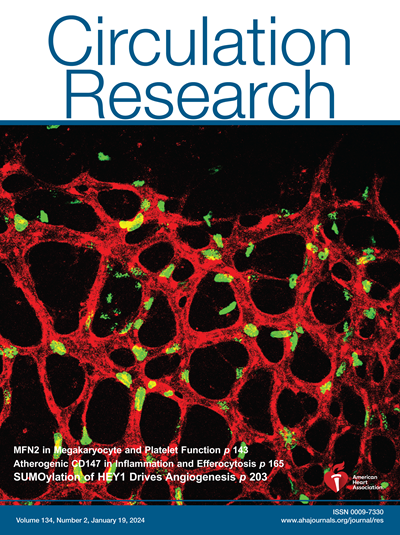Vascular Niches Are the Primary Hotspots in Cardiac Aging.
IF 16.2
1区 医学
Q1 CARDIAC & CARDIOVASCULAR SYSTEMS
引用次数: 0
Abstract
BACKGROUND Aging is a major, yet unmodifiable, cardiovascular risk factor and is associated with vascular alterations, increased cardiac fibrosis, and inflammation, all of which contribute to impaired cardiac function. However, the microenvironment inciting age-related alterations within the multicellular architecture of the cardiac tissue is unknown. METHODS We investigated local microenvironments in aged mice hearts by applying an integrative approach combining single-nucleus RNA sequencing and spatial transcriptomics of 3- and 18-month-old mice. We defined distinct cardiac niches and studied changes in their cellular composition and functional characteristics. We treated mice with broad-spectrum senolytics dasatinib and quercetin, and endothelial-specific senolytic fisetin and studied their effects on senescence and macrophage populations. RESULTS Integration of spatial transcriptomics data across 3- and 18-month-old hearts allowed the identification of 11 cardiac niches, which were characterized by distinct cellular composition and functional signatures. Aging did not alter the overall proportions of cardiac niches but led to distinct regional changes, particularly in the left ventricle. While cardiomyocyte-enriched niches showed disrupted circadian clock gene expression, vascular niches showed major changes in proinflammatory and profibrotic signatures and altered cellular composition. We particularly identified larger vessel-associated cellular niches as key hotspots for activated fibroblasts and bone marrow-derived Lyve1- and resident Lyve1+ macrophages in aged hearts, with interactions of both cell types through the C3:C3ar1 axis. These niches were also enriched in senescent cells exhibiting high expression of immune evasion mechanisms that may impair senescent cell clearance. Removal of senescent cells by senolytics reduced the presence of Lyve1- macrophages. CONCLUSIONS Our findings indicate that the perivascular microenvironment is particularly susceptible to age-related changes and serves as a primary site for inflammation-driven aging, so-called inflammaging. This study provides new insights into how aging reshapes cardiac cellular architecture, highlighting vessel-associated niches as potential therapeutic targets for age-related cardiac dysfunction.血管壁龛是心脏老化的主要热点。
背景:衰老是一个主要但不可改变的心血管危险因素,与血管改变、心脏纤维化增加和炎症有关,所有这些都有助于心功能受损。然而,在心脏组织的多细胞结构中,引发年龄相关改变的微环境是未知的。方法采用单核RNA测序和空间转录组学相结合的方法,对3月龄和18月龄小鼠心脏局部微环境进行研究。我们定义了不同的心脏生态位,并研究了它们的细胞组成和功能特征的变化。我们用广谱抗衰老药达沙替尼、槲皮素和内皮特异性抗衰老药非瑟酮治疗小鼠,研究它们对衰老和巨噬细胞数量的影响。结果整合3个月和18个月大心脏的空间转录组学数据,鉴定出11个心脏生态位,这些心脏生态位具有不同的细胞组成和功能特征。衰老不会改变心脏生态位的总体比例,但会导致明显的区域变化,尤其是在左心室。虽然富含心肌细胞的壁龛显示生物钟基因表达被破坏,但血管壁龛显示促炎和促纤维化特征的主要变化以及细胞组成的改变。我们特别确定了较大的血管相关细胞壁龛是老年心脏中活化的成纤维细胞和骨髓来源的Lyve1-和常驻Lyve1+巨噬细胞的关键热点,两种细胞类型通过C3:C3ar1轴相互作用。这些小生境也在衰老细胞中富集,表现出可能损害衰老细胞清除的免疫逃避机制的高表达。用抗衰老剂去除衰老细胞可减少Lyve1-巨噬细胞的存在。研究结果表明,血管周围微环境特别容易受到年龄相关变化的影响,并且是炎症驱动衰老的主要部位,即所谓的炎症。这项研究为衰老如何重塑心脏细胞结构提供了新的见解,强调了血管相关利基作为年龄相关性心功能障碍的潜在治疗靶点。
本文章由计算机程序翻译,如有差异,请以英文原文为准。
求助全文
约1分钟内获得全文
求助全文
来源期刊

Circulation research
医学-外周血管病
CiteScore
29.60
自引率
2.00%
发文量
535
审稿时长
3-6 weeks
期刊介绍:
Circulation Research is a peer-reviewed journal that serves as a forum for the highest quality research in basic cardiovascular biology. The journal publishes studies that utilize state-of-the-art approaches to investigate mechanisms of human disease, as well as translational and clinical research that provide fundamental insights into the basis of disease and the mechanism of therapies.
Circulation Research has a broad audience that includes clinical and academic cardiologists, basic cardiovascular scientists, physiologists, cellular and molecular biologists, and cardiovascular pharmacologists. The journal aims to advance the understanding of cardiovascular biology and disease by disseminating cutting-edge research to these diverse communities.
In terms of indexing, Circulation Research is included in several prominent scientific databases, including BIOSIS, CAB Abstracts, Chemical Abstracts, Current Contents, EMBASE, and MEDLINE. This ensures that the journal's articles are easily discoverable and accessible to researchers in the field.
Overall, Circulation Research is a reputable publication that attracts high-quality research and provides a platform for the dissemination of important findings in basic cardiovascular biology and its translational and clinical applications.
 求助内容:
求助内容: 应助结果提醒方式:
应助结果提醒方式:


